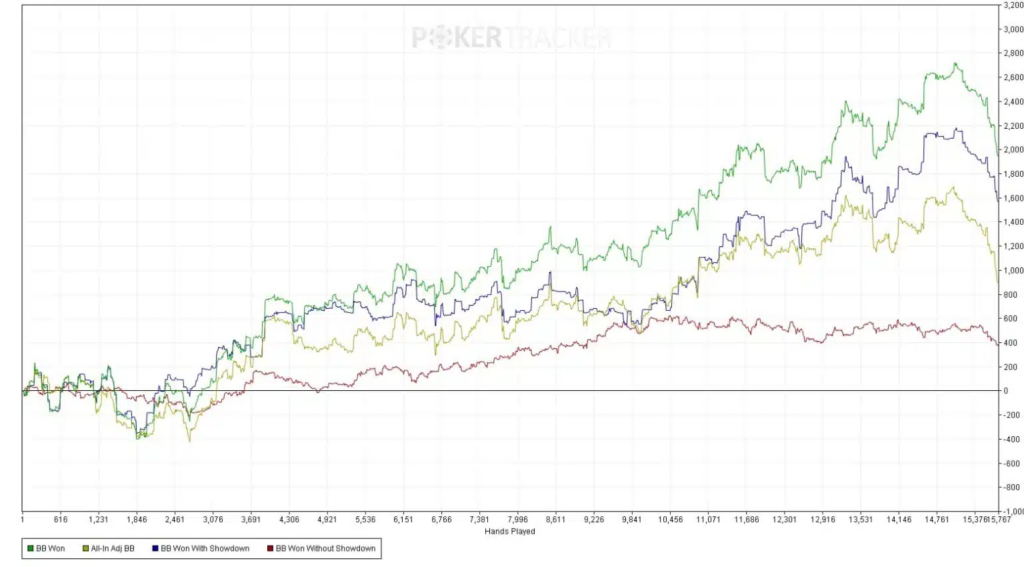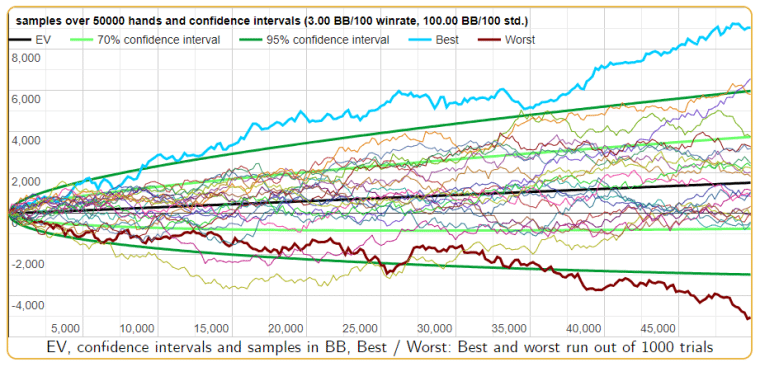Poker bankroll management is undoubtedly one of the most underrated aspects of the game. For players looking to move up in stakes and progress themselves in poker, money management is just as important as knowing which hands to play and how to navigate a flop.
Many players have caused themselves to go broke despite having a skill edge over their opponents, purely because of poor poker bankroll management. In this guide, we’ll explain how to avoid making the same mistakes. We’ll give you some solid rules of thumb to abide by, and explain the principles to guide all your bankroll decisions.
The Importance of Bankroll Management in Poker
It cannot be overstated how important bankroll management, or BRM, is in poker. No matter how good a player you are, with poor bankroll management, you’re certain to end up broke in the long run. By contrast, a player with a small edge can be very profitable if they adhere closely to the correct principles.
Many professional gamblers make use of formulas like Kelly Criterion to decide how much of their bankroll to risk on any individual bet. However, in poker, winrates are unclear, and there are many stakes available, which makes it more difficult to plan a proper bankroll strategy.
Poker bankroll management strategies assume that the player is beating the games they play. If you’re still learning the game of poker, it’s more important to focus on your own game and improve your basic level of strategy first.
However, while it’s true that no amount of good bankroll strategy will save a losing player from going broke in the long run, it may buy them enough time to improve their game and become a winning player. As a result, poker bankroll management is essential for players of all levels to understand.
The Three Pillars of Poker Bankroll Management
There are different strategies and schools of thought on optimal poker bankroll management. However, all of them will contain several core principles. These three pillars should help you always play in a way that won’t risk too much the money in your bankroll at once.
Rule One: Move Down When Necessary
The core principle of Poker bankroll management is to always have a sufficient bankroll for the game you’re playing. This means that if you have a bad run and no longer have enough buyins for your game, you should immediately move down in stakes.
By far the most common way that winning players go broke is refusing to move down in stakes during a downswing. Even worse, some players move up in stakes during a downswing in an attempt to win their money back quickly, leaving themselves even more exposed to further bad runs. This is almost a guaranteed route to self-destruction, and one that even top pros like Phil Laak have experienced over their career.
It’s important to be disciplined to fold a big hand when facing a big river bet from a nit, and it’s also important to be disciplined and move down as soon as you’re under-rolled for the stakes you’re playing.
Rule Two: Don’t be a bankroll nit
Being too cautious with your bankroll may seem safer and less risky than being too aggressive. However, it can cost winning players just as much money in the long run.
If you’re winning at 5bb/100 at 50NL online, you may well have a winrate of 4bb/100 at 100NL online. Over a sample of 50,000 hands, that amounts to an average of $1,250 won at 50NL, but $2,000 at 100NL. In addition, rake tends to be lower as you move up in stakes, which can compensate for lower winrates.
When you’ve got enough room in both your bankroll and your winrate to take a shot at higher stakes, you shouldn’t hesitate to take the plunge – so long as you remember rule one when you move up.
Rule Three: Don’t underestimate variance
Don’t make the mistake of underestimating just how bad a downswing can be. This is particularly true for online poker bankroll management, where winrates are lower. As a result, you shouldn’t make sweeping assumptions about your winrate over a small sample. Taking variance into account is crucial for all forms of gambling bankroll management, like playing casino games, but the extreme swings in poker make it even more crucial.
Many players would consider 50,000 poker hands to be a lot. However, with a 3bb winrate at 100NL, the variance over this sample will be huge. Put into a Poker Variance Calculator, even a decent winning player can end up losing money over 50,000 hands. In fact, one sample finished down over $6,000. On the flipside, it’s important not to overestimate your own edge because of a small winning run.
Poker Bankroll Management Charts: How Many Buyins Should You Have?
The following tables will show you what bankroll you should have in order to play those stakes. In general, you’ll need less buyins for smaller stakes games, and especially live games, where winrates are higher than online. As you move up stakes, play online, and play higher variance games like tournaments or Pot Limit Omaha, you’ll need more buyins.
In the tables below, each game will show you the ‘Required Bankroll’, at which point you can move up to play that game. The ‘Move Down Below’ column shows when you should move down in stakes once you have less than that amount for the specified game. By following these tables, you’ll be able to easilly calculate your bankroll required for whatever game you want to play.
No-limit Hold’Em Online Cash Games
| Stakes | Buyins Required | Bankroll Required | Move Down Below |
|---|---|---|---|
| $0.01/$0.02 | 50 | $100 | N/A |
| $0.02/$0.05 | 50 | $250 | $175 |
| $0.05/$0.10 | 60 | $600 | $420 |
| $0.10/$0.20 | 60 | $1,200 | $840 |
| $0.10/$0.25 | 60 | $1,500 | $1,050 |
| $0.25/$0.50 | 70 | $3,500 | $2,450 |
| $0.50/$1.00 | 75 | $7,500 | $5,250 |
| $1.00/$2.00 | 80 | $16,000 | $11,200 |
| $2.50/$5.00 | 100 | $50,000 | $35,000 |
| $5/$10 | 100 | $100,000 | $70,000 |
No Limit Hold’Em Live Cash Games
| Stakes | Buyins Required | Bankroll Required | Move down below |
|---|---|---|---|
| $1/$2 | 25 | $5,000 | N/A |
| $1/$3 | 25 | $7,500 | $5,250 |
| $2/$5 | 30 | $15,000 | $10,500 |
| $5/$10 | 35 | $35,000 | $24,500 |
| $10/$20 | 40 | $80,000 | $56,000 |
| $25/$50 | 40 | $200,000 | $140,000 |
| $50/$100 | 40 | $400,000 | $280,000 |
Pot Limit Omaha Online Cash Games
| Stakes | Buyins Required | Bankroll Required | Move down below |
|---|---|---|---|
| $0.01/$0.02 | 70 | $140 | $98 |
| $0.02/$0.05 | 70 | $350 | $245 |
| $0.05/$0.10 | 80 | $800 | $560 |
| $0.10/$0.20 | 80 | $1,600 | $1,120 |
| $0.10/$0.25 | 90 | $2,250 | $1,575 |
| $0.25/$0.50 | 100 | $5,000 | $3,500 |
| $0.50/$1.00 | 120 | $12,000 | $8,400 |
| $1.00/$2.00 | 120 | $24,000 | $16,800 |
| $2.50/$5.00 | 140 | $70,000 | $49,000 |
| $5/$10 | 150 | $150,000 | $105,000 |
Pot Limit Omaha Live Cash Games
| Stakes | Buyins Required | Bankroll Required | Move down below |
|---|---|---|---|
| $1/2 | 50 | $10,000 | $7,000 |
| $1/$3 | 50 | $15,000 | $10,500 |
| $2/$5 | 65 | $32,500 | $22,750 |
| $5/$10 | 75 | $75,000 | $52,500 |
| $10/$20 | 80 | $160,000 | $112,000 |
| $25/$50 | 100 | $500,000 | $350,000 |
| $50/$100 | 100 | $1,000,000 | $700,000 |
Poker Tournament Bankroll Management
MTT bankroll management is more complex than for cash games, because players do not play the same stakes all the time. In addition, the difficulty of tournaments and the buyin level are not as closely aligned as with cash. Many major festivals will have main events which attract lots of recreational players, making them softer than standard tournaments with a lower buyin.
For these reasons, tournament players should be careful about moving up in stakes immediately after a big win. However, you should also be much more prepared to take bigger shots when a soft tournament is available to play. As a result, this guide should be treated much more roughly than the cash game bankroll management guide.
Live Multi-Table Tournaments
| Average Buyin | Buyins Required | Bankroll Required | Move down below |
|---|---|---|---|
| $20 | 100 | $2,000 | $1,400 |
| $50 | 100 | $5,000 | $3,500 |
| $100 | 110 | $11,000 | $7,700 |
| $200 | 120 | $24,000 | $16,800 |
| $500 | 130 | $65,000 | $45,500 |
| $1000 | 140 | $140,000 | $98,000 |
| $2500 | 150 | $375,000 | $262,500 |
Online Multi-Table Tournaments
| Average Buyin | Buyins Required | Bankroll Required | Move down below |
|---|---|---|---|
| $5 | 140 | $700 | $490 |
| $10 | 150 | $1,500 | $1,050 |
| $20 | 170 | $3,400 | $2,380 |
| $50 | 180 | $9,000 | $6,300 |
| $100 | 190 | $19,000 | $13,300 |
| $250 | 220 | $55,000 | $38,500 |
| $500 | 240 | $120,000 | $84,000 |
Aggressive Poker Bankroll Management

While the tables above demonstrate good rules of thumb, there are some exceptions. Sometimes, it pays to be more aggressive than normal to maximise the return on your bankroll for poker.
Whenever a game is softer than usual, or you have a very high winrate, you can afford to keep a lower bankroll. This shouldn’t be taken to the extreme, however. Make a slight reduction, allowing for both variance and the fact you may be overestimating your winrate.
In addition, you can typically be more aggressive and keep a lower number of buyins when the stakes are lower. Suppose you only keep 20 buyins ($100) for playing 5NL online compared to 20 for 500NL ($10,000). If you go broke, it is a lot easier to make $100 outside of poker than $10,000.
This has been factored into the above tables – and in addition, winrates will be higher at very low stakes. Lastly, it is also important to take advantage of any sign-up bonuses for real money online poker sites. This can increase your winrate and reduce your risk of a downswing. To find out if there are any bonuses available for you, check our page on the top real money online poker sites.
Shot Taking in Poker: When to Move Up in Stakes
Players may also consider deviating from the above tables is when another game is particularly soft. For cash players, playing at a certain time of day or when there are many recreational players in the pool above is an ideal time to take a shot while their winrate will be at its highest.
As discussed, tournament players will often have soft major festivals that come around on the circuit each year. Tournament players also have the option of making games fit their bankroll by selling action. This can be an effective method of playing larger tournaments without risking too much of your bankroll. However, this should only be used to enter a tournament because you expect to have a high edge, not merely for the size of the prizepool.
Poker Bankroll Management Apps
There’s plenty of software out there to help you manage your bankroll more effectively. Here are a few of the best options, whether you’re playing online or live.
Tracking Software – PokerTracker 4, Hold’Em Manager 3, Hand2Note

All of these three programs are excellent for online players. They’ll track all of your hands played, giving you detailed stats about your play as well as your winrate. However, they don’t work on all online poker sites. It’s important to check that they’re functional on the site you play on before you pay for them.
These programs also come with a Heads Up Display that you can use to boost your winrate on sites that allow them. However, being able to analyse your game in detail with filters is one of the most effective ways of using them. Singling out any particular situation or hand, you can identify any leaks in your game much easier than if you had no objective data to go from. You can also track your progress across multiple stakes and multiple sites, giving you a complete breakdown and review of your poker game as a whole.
Between the three of them, they mostly offer the same features and are functional on the same sites. Free trials are available though, and most players have a particular preference for one user interface or the other, so you should try them out and see which one works best for you before paying out for the full program.
Primedope Variance Calculators

These are excellent tools for visualizing the level of risk being taken when employing poker bankroll management. The calculator can show the variance in simulations from an estimated winrate and the number of games or hands you’ll be playing. They’re also completely free to use and don’t require any downloads.
Playing around with the app for both cash games and tournaments can help you understand just how bad (or good) variance can be for the average player. It helps you to understand why you need so many buyins even for games you might be crushing. In addition, it helps to better visualise that even over a seemingly large sample, chance may have played a larger role than most players would typically imagine.
Poker Bankroll Tracker
This app is a very useful tool for live poker bankroll management, allowing you to easily track your winrate over many sessions from your mobile. By keeping detailed notes, you’ll have a better understanding of your likely winrate. You can also potentially spot any patterns for when you might be more successful playing in certain games, at certain venues, or even at certain times of day.
It’ll also be easier to track your bankroll even if you don’t keep it in a dedicated account. All you’ll need to do is add the starting figure in, and then post your results after each session you play. The app will keep track of the rest, and let you see how you’re doing over the long run.









